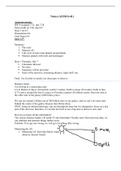Notes (ASTR-S-41)
Announcements:
HW 4 assigned 7/21, due 7/28
Extra credit on 7/26, due 8/2
Quiz 3 on 8/2
Presentation 8/4
Final Paper 8/5
June 21 st : Summary: 1.The scale
2.Measure AU
3.Life cycle of stars (also planets around them)
4.Measure planets with tools and techniques
Quiz 1 Thursday, July 7
Calculator allowed
No notes
Equations will be provided
Scale of the universe; measuring distance; light stuff; sun
Final: Use Exofast to model; use telescopes to observe
Distance Scale: Use driving as a measuring scale: LA to Boston (2 days); Around the world (3 weeks); Earth to moon (30 weeks); Earth to Sun (175 years); around the Sun (5 years); to Proxima centauri (50 million years); from one side to the other side of the galaxy (600 billion years)
We can see around 2 billion out of 300 billion stars in our galaxy, and we can’t see most stars behind the center of the galaxy because dust blocks them.
JWST, being an infrared telescope, can see through the dust, but it is designed to focus on a tiny part of the universe; therefore, it’s not the best tool to see a big area or discover new stars.
How do we know all the information?
The cosmic distance ladder: On Earth>To the Sun(radar)>Nearby stars>from previous data, we can calibrate and measure things further away
Problem: If we get one wrong, we will get everything after wrong
Measuring the AU: 1.Measuring AU from Sun-Moon Angle
(done by ancient Greek) 2.Kepler measured distance to Mars, so he can understand the scale of the solar system
3.Transits of Venus helped them to find the distance of AU
4.Now we use radar to measure AU (~3m) Measuring the AU here:
We have: Spectrograph; image the Sun, accurate clocks, telescope
There are two methods to measure the angular diameter of the Sun: 1.Timing experiment: using earth’s rotation to measure the time needed for Sun to move the distance of its diameter. Uncertainty: The effect of revolution is ignored ; the position of the observer is ignored
2.Pinpoint experiment: we will measure the distance and angle from pinpoint to paper. It has the same ratio of Sun to the pinpoint. Uncertainty: measurement from the pinpoint to the paper is not precise enough. Also, it was the Summer Solstice. NOTE: the actual point is not above the plate, it is way too small to be included. Also the hole itself acts as a point.
After measuring the angular diameter, we now need to know the angular velocity (how fast it turns) of the Sun, because we can get Sun’s diameter from it.
Using sunspots, which generally remain in their positions, we can use r=vT/2pi, to get the radius of the plane which the sunspot moves on.
However, I don’t know how we are going to find the velocity which the sunspot has because velocity=distance/time, and distance is 2piR/time
June 23 rd : Scientific Notation:
9.38e3, e3 refers to 10*3, so that is 9380
Sig Figures:
Should be consistent
Dimensional Analysis (a powerful sanity check):
Keep the unit, so we know we are talking about the same things
Units commonly used: Theta is an angle—units of radians
T is time—units of time
A is an angular acceleration—radians/time*2 Is the angular velocity—radian/time
Parallax: If you know the length of the baseline and the degree of Theta, you can calculate the distance to the object.
If we use the Earth’s orbit around the Sun, we get a baseline of 2AU
We can measure the temperature of a star by looking at its color, and from its color, we can know its luminosity. Knowing its luminosity, we can compare it to the apparent brightness to find its distance.
The Cephid constant: A variable star will change its magnitudes of luminosity over time. The one that has a longer period will be brighter>more luminosity. We can find its distance form parallax; we can find its period by looking at its change in luminosity. We also know its luminosity. Using we these data, we can use them as a scale/ruler to measure other things.
White dwarf supernova. (A standard supernova candle) We know their luminosity, so if we move
them away, we can tell its distance by measuring its apparent brightness. It always explodes in the same luminosity. We can investigate distant galaxies, and if we see these supernovae, we can compare its luminosity with its apparent brightness, we can find its distance.
The distance of these galaxies is closely related to its redshift. We know everything is moving away from each other because of the redshift. Not everything is moving away from us, but we are part of the expansion. Thus, we know the universe is expanding.
Light is pretty important to us, and we can use it to measure the distance to stars.
Vocab: Electromagnetic spectrum=radiation
Equation: c= x frequency (speed of radiation=wavelength x frequency)
Energy (E)=plank’s constant (h) x frequency
Energy in terms of wavelength (E ( )) = hc/
Proving light is both photon and wave. Double spilt experiment: If we shine light through two gaps onto a wall, we will see multiple gaps on the wall because light acts like waves. The waves interact and shines onto the wall. However, if we put a detector on the wall, we will see photons one by one hitting the detector. When we measure it, light becomes photons, and the wave collapses (Quantum mechanics). The point being, we must make sure to acknowledge its unique property when measuring it.




